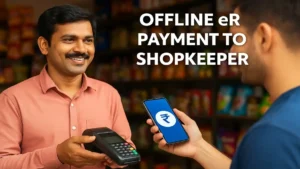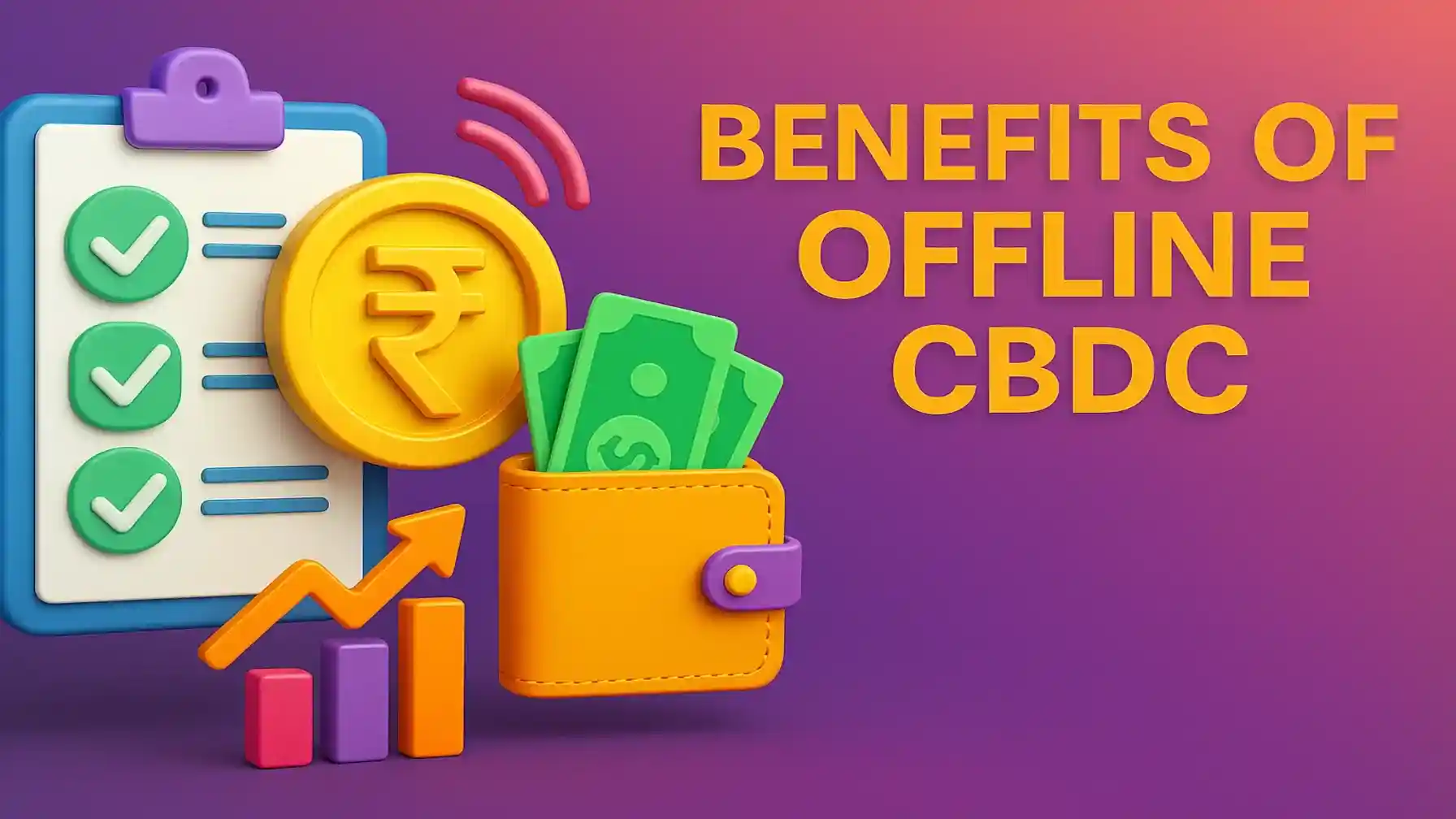The Offline CBDC is reshaping how India pays, saves, and transacts. Announced by the Reserve Bank of India (RBI) at the Global Fintech Fest 2025, this digital rupee lets people make payments even without an internet or mobile signal. Imagine paying for tea in a hill station or shopping in a rural market with just a tap – no connectivity needed.
This system bridges the digital gap between urban and rural India. It works like real cash – instant, private, and easy – but with all the advantages of digital payments. The RBI’s vision is simple: financial inclusion that works for everyone, everywhere.
From UPI to Offline CBDC: India’s Digital Journey:
India’s digital payment story began with UPI in 2016. It made transferring money simple and fast but needed internet access. For millions in remote areas, that was a problem.
To fix it, the RBI launched the digital rupee in 2022. Then, in 2025, came the real breakthrough—Offline CBDC, a version that works completely without connectivity. This move brought digital money to the remotest corners of the country.
Also Read: Register Instantly for SBI WhatsApp Banking Service
Now, whether you’re in a metro city or a small village, digital payments are possible with just a tap. It’s one of the biggest steps toward building a truly connected, cash-free India.
What Exactly is Offline CBDC?
The Offline CBDC is a digital form of India’s official currency, issued directly by the RBI. It holds the same value as the cash in your pocket but lives inside a secure wallet on your phone, card, or smart device.
Unlike cryptocurrencies, which are volatile and unregulated, the digital rupee is backed by the central bank. When two wallets come close, they connect through Near Field Communication (NFC) or Bluetooth and exchange value instantly.
This simple design lets people pay or get paid anywhere, even in areas with no signal or electricity. It’s cash made digital, and it’s built for everyone.
How the System Works in Real Life?
Payments through the Offline CBDC are fast and intuitive. When two devices come within range, they authenticate each other using encrypted codes. Once verified, the tokens—each representing a digital rupee—move directly from one wallet to another.
There’s no internet, no bank server, and no waiting. Later, when either device reconnects, it automatically updates the transaction with the RBI’s central system.
This setup mimics a real cash hand-over but adds digital security and accountability. Every exchange is instant, final, and traceable once synced.
Key Features that make Offline CBDC Special:
1. Instant Payments Without Internet
Transactions take seconds, even without data or Wi-Fi. You can buy groceries, pay for transport, or send money to friends anywhere—no signal required.
This feature makes digital payments dependable in all conditions, from bustling cities to remote villages.
2. Programmable Money
One exciting feature of the Offline CBDC is programmability. It allows funds to come with built-in rules. For example, a government subsidy can be used only for farm supplies, or a corporate allowance can go only to specific vendors.
That means less misuse, greater control, and smarter spending—all while keeping things simple for users.
3. Security You Can Trust
Every wallet has a tiny chip called a secure element that keeps data safe. Add biometric or PIN verification, and the system becomes nearly tamper-proof.
Even if a device is lost, funds can be restored once verified with the bank. The RBI’s approach makes this digital rupee as safe as cash—if not safer.
Bringing Financial Inclusion to Everyone:
One of the main goals of this digital rupee is inclusion. Millions in India still struggle with poor connectivity or limited banking access. The Offline CBDC changes that.
Farmers, vendors, and workers in rural areas can now send or receive payments instantly without depending on banks or mobile data. At the Global Fintech Fest, the RBI showed how a tea vendor in the Himalayas accepted digital rupees from a tourist using tap-to-pay—zero signal, full success.
For many, this isn’t just convenience; it’s empowerment. It gives every Indian equal access to digital finance.
Offline CBDC vs. UPI: The Clear Difference
While both systems help move money digitally, their mechanics are different. UPI connects your bank accounts using the internet. The Offline CBDC stores value directly in wallets, removing the need for online banking during transactions.
| Feature | UPI | Digital Rupee (Offline) |
|---|---|---|
| Internet Required | Yes | No |
| Settlement | Bank servers | Wallet-to-wallet |
| Intermediaries | Multiple | None |
| Speed | Depends on network | Instant |
| Ideal For | Online users | Low-connectivity areas |
Together, they make India’s payment ecosystem unbeatable—UPI for online, the digital rupee for offline.
Benefits for Businesses and Everyday Users:
Faster, Cheaper Payments
Merchants don’t have to wait for settlements or pay third-party fees. Funds appear instantly in their wallets. For small businesses, this means better cash flow and fewer failed transactions.
Micro-Payments and Small Transactions
The digital rupee makes it easy to pay tiny amounts—a few rupees for snacks, bus rides, or local goods. It’s perfect for micro-commerce and daily needs.
Simple and Inclusive
The system is designed for everyone. Whether you use a smartphone, card, or hardware wallet, the experience stays smooth and intuitive. Tap, confirm, and go—it’s that simple.
How Governments benefit too?
The Offline CBDC isn’t just about convenience; it also helps governance.
Efficient Subsidy Distribution
Programmable features make welfare payments more transparent. Funds can be sent directly to beneficiaries and restricted to specific uses. And since it works offline, even remote recipients can get their money immediately.
Smarter Policy and Transparency
After syncing, anonymized transaction data helps the RBI understand spending patterns and improve policymaking. The system keeps user privacy intact while offering valuable insights for a more efficient economy.
Technology Powering the Digital Rupee
Behind this seamless experience is a blend of NFC, encryption, and secure elements. These technologies ensure that offline transactions remain safe and authentic.
For those without smartphones, affordable hardware wallets or NFC cards provide the same functionality. This combination of simplicity and safety is what makes India’s central digital currency stand out worldwide.
 Challenges Ahead:
Challenges Ahead:
Of course, no new system is without hurdles.
User Awareness
Some users, especially in rural areas, may need time to understand how digital rupees work. The RBI and partner banks are already running educational drives to make adoption easier.
Maintaining Privacy and Security
The RBI’s system hides personal details while keeping transactions verifiable. Balancing these two goals will be key to long-term trust.
Preventing Double Spending
Offline transactions risk being duplicated before syncing. The RBI’s reconciliation process prevents this by checking all tokens once devices reconnect.
Global Attention on India’s Model
India’s innovation has caught global eyes. Countries in Africa, Asia, and South America—many facing similar connectivity challenges—are exploring India’s blueprint to launch their own offline digital currencies.
The success of this system positions India as a world leader in inclusive financial technology, setting a new benchmark for others to follow.
The Future of Digital Rupee:
Looking ahead, the RBI plans to integrate artificial intelligence and IoT devices. Imagine your smart meter paying your electricity bill automatically using stored digital rupees—even offline.
Pilot projects are expanding across cities and rural regions alike. Over time, this currency could replace much of the small-value cash still in circulation, making India truly digital in every sense.
Conclusion: Offline CBDC – A Leap Toward Inclusive Finance
The Offline CBDC is more than just a payment tool—it’s India’s answer to financial inclusivity. By enabling secure, cash-like transactions without internet, it ensures that no one is left behind in the digital revolution.
From rural farmers to city professionals, everyone can now pay and get paid effortlessly. With this move, India proves that innovation doesn’t have to exclude—it can connect. The digital rupee is not just money reimagined; it’s money made smarter and more human.
FAQs:
1. What is the Offline CBDC?
It’s a digital form of India’s official currency that allows transactions without internet or mobile connectivity.
2. How does it work offline?
Two wallets connect through NFC or Bluetooth to transfer value instantly. Once online, balances sync with the RBI.
3. Is it secure?
Yes. It uses encryption, secure chips, and biometric verification to keep every transaction safe and private.
Also Read: Central Bank Digital Currency: The eRupee Revolution in India
4. Can I use it without a smartphone?
Absolutely. You can use an NFC-enabled card or hardware wallet to make payments easily.
5. When will it be available across India?
The RBI launched pilots in 2025 and plans a gradual nationwide rollout soon after.

